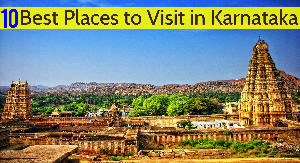Coorg is nestled in the Western Ghats. It has risen to fame as one of the top tourist destinations, offering an awe-inspiring experience within the ethereal splendour of its mountains. This site will surely inspire your next travel adventure. The sloping terrain of Coorg creates an extraordinary destination with low populace density, inviting you to revel in peace among thick vegetation and glorious weather. With its serene atmosphere, Coorg merges history and topography, crafting a remarkable attraction that beckons tourists seeking an enriching and tranquil experience. Immerse yourself in the beauty of Coorg's tourist places. Each offers a unique blend of history, nature, and tranquillity, creating an intriguing and exciting experience that will leave you wanting more.


By the age of 25, I – perhaps matching the average Indian – had visited, as far as my memory goes, at least 10 historical forts. That was ten opportunities to witness the Archaeological Survey of India’s devotion to disrepair. At least ten exposures to guides who promised to transport the tourist to the courtroom of that great historical figure who once ruled these ramparts. Perhaps ten decent vistas into the surrounding countryside. And around a hundred glorious declarations of unrequited love, etched into sooty walls by perpetually-adolescent males.
With this air of cynicism and condescension, I begin exploring the Madikeri Fort and find most of my assumed template missing. The Karnataka government’s archaeological office is locked on the morning of my visit and will stay locked the whole day according to the security guard. The vistas overlooking the town are unimpressive; and the mandatory tourist guide, who might help me make sense of the place, is conspicuously absent. I will discover these aspects soon. For the first two minutes, everything is as expected. The high archway through which I enter leads to a customary series of 90 degree turns – I suppose these eliminated the possibility of charging elephants during battle. And then, just like that, I see a temple. Not an ancient shrine, mind you. The sanctum sanctorum appears to be housed inside an old stone structure, but the painted façade and sheet roofing at the entrance belong to the computer age. The coexistence of two different eras piques my interest.
I sidestep the temple, walk through a nondescript arch and enter an expansive area dotted with many buildings whose architecture cannot be attributed to Tipu Sultan. At first glance, they look British and impressive. The closer I walk to the largest building, however, the less impressive it becomes. Untidy scaffolding seems to be holding the building in place. At least the clock in the tower seems to be working, I think, till the security guard reminds me that even a broken clock is correct twice a day. Till 2019, this building was the Deputy Commissioner’s office and, according to a rudimentary internet search, the location of the district treasury, home to a small portion of Mahatma Gandhi’s ashes for many decades. Yes, Kodagu is one of the many places in India and abroad which received his ashes.
On the other side of the DC’s office stands the district courthouse, which is yet to be relocated. It is bustling with lawyers and feuding parties and looks no more remarkable than the average government building. The museum is far more interesting. I am usually flummoxed by the typical museum’s fixation on tools of war, but given the gallantry of the Kodavas, the exhibition of weaponry and plaques commemorating war heroes don’t feel out of place here.
Exiting the museum, I wait patiently for cars visiting the courthouse to pass and then walk up a ramp leading to a pathway right next to the fort’s walls. The midmorning sun and the springtime freshness of the hill station make my walk enjoyable. From this vantage point of the premises, I see abandoned auto rickshaws, a volleyball court, a post-box, more buildings in advanced stages of decay and the famous life-size elephant statues that pose patiently with selfie-seekers.
As I walk back to my hotel, I find my cynicism melting and begin to appreciate the uniqueness of the Madikeri Fort.
Most Indian forts are in ruins, literally. This one is refreshingly different because it has been constantly repurposed ever since Muddu Raja, the 17th-century ruler of Kodagu, built a mud fort. As the fort came into the hands of Tipu Sultan, mud gave way to granite, which must have been transported here from far, on carts, through dusty uphill roads. Tipu’s exit ushered in an era of European-style buildings that have been treated like hand-me-down clothing in a poor household.
- The former DC office was a palace built in 1814 by Lingarajendra Wodeyar II.
- The museum used to be a Gothic church that was built at the same site as a Veerabhadra Temple.
- A building in the lowest courtyard used to be a prison which was, for a period of time in the recent past, repurposed as an orphanage for girls.
- And today, given the trail of cigarette butts and tetra packs of rum and whiskey strewn adjacent to the fort walls, the whole premises apparently gets transmogrified into a place for revelry in the night!
Somehow, the fort has managed to balance legacy and functionality. That’s why the locals visit it as much as the tourists, if not more. But the exodus of government offices from these premises, which was hastened by a Karnataka High Court ruling, marks the end of an era when the buildings were alive and in use. In addition to the DC’s office and the Zilla Panchayat, the public library and the anti-corruption bureau have already been relocated. What will happen when the courthouse and the agriculture department follow suit? Will all the buildings turn into ruins? Or will Karnataka’s archaeological department successfully revamp the place and get it ready for a new era of history being repurposed?
Recommended For You
-
 Best Places to Eat in Goa: Indulge in a Culinary Delight
Best Places to Eat in Goa: Indulge in a Culinary Delight
-
 The Future of Drone Tourism: How Drones are Changing the Travel Industry
The Future of Drone Tourism: How Drones are Changing the Travel Industry
-
 10 Reasons Why Diwali is Celebrated
10 Reasons Why Diwali is Celebrated
-
 Significance of Navratri and Durga Puja
Significance of Navratri and Durga Puja
-
 Why and How is Dussehra Celebrated All Over India?
Why and How is Dussehra Celebrated All Over India?
-
 Top 10 Drone and Aviation Training Institutes in India
Top 10 Drone and Aviation Training Institutes in India

























Author Bio